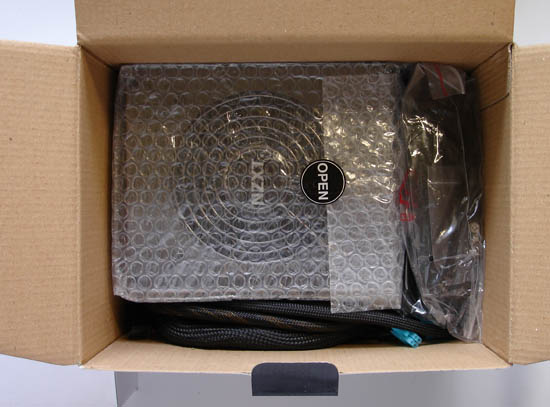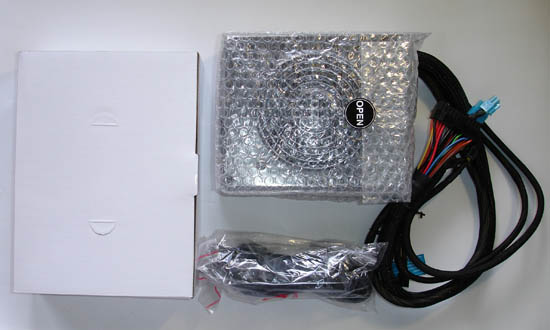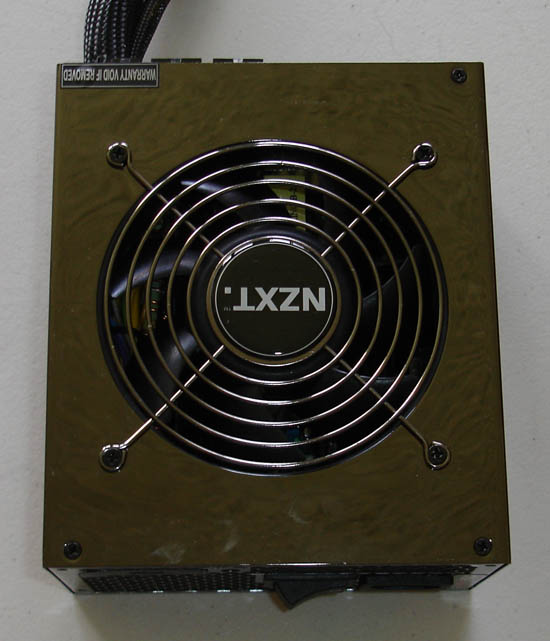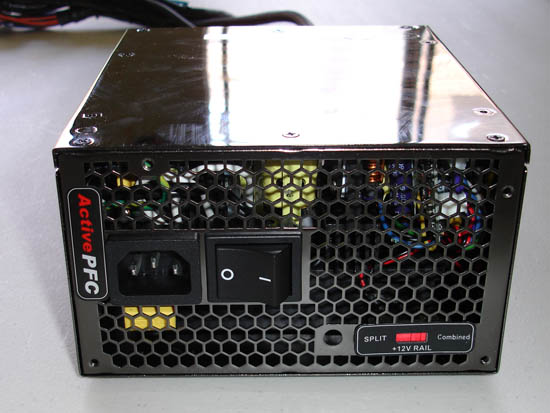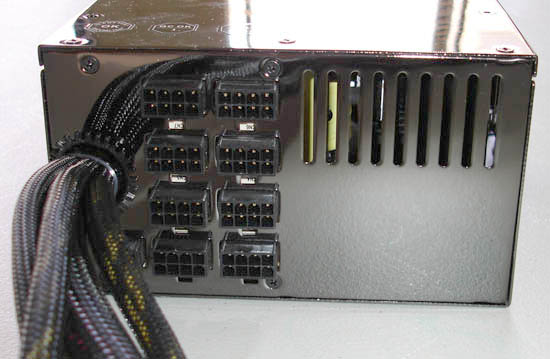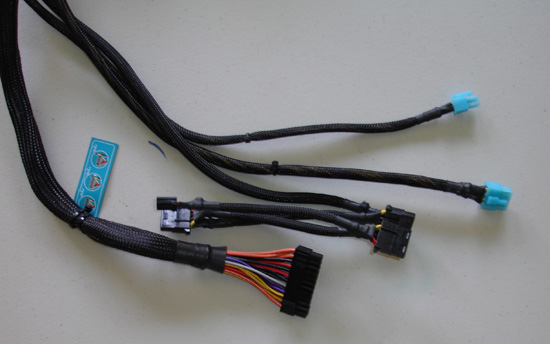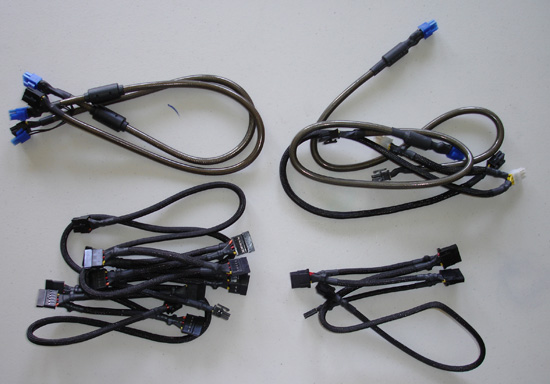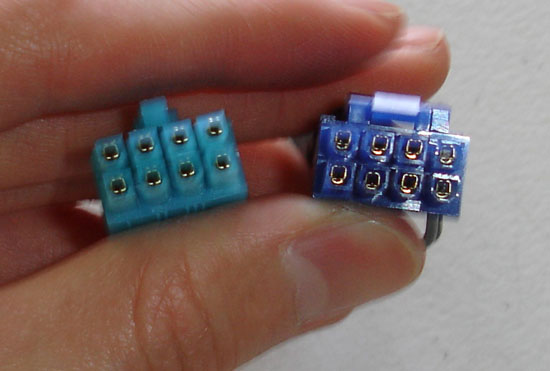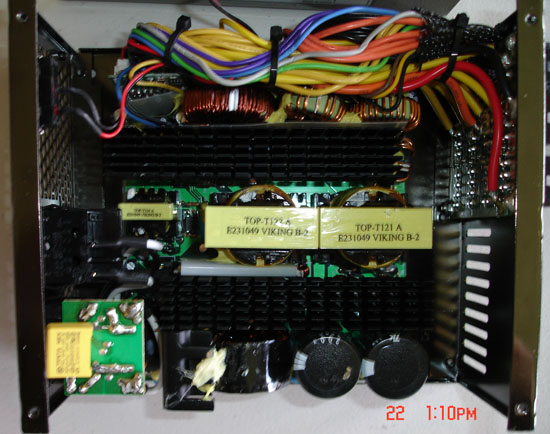NZXT’s first high end power supply, the Precise 1000W, pakced with a lot of great features, such as modular design, the ability to swtich between combine and split +12V, six +12V rails that will power even the most demanding system on the market. What’s more, the power supply comes with 6 PCIe connectors that will power not only 3 8800GTX cards but also have the ability to power next generation of graphic cards. What’s more amazing is that this PSU’s size is standard ATX PSU size rather over-sized PSUs like some other 1000W PSU. It looks promising but can it performs as good as it seems, check out our review as we test this PSU out.
INTRODUCTION
THE COMPANY

NZXT, a company built upon gamer’s dreams, hopes to create products that put consumers first. Our objective is to provide every gamer with a case that they can identify with. Combining unique design and case performance, consumers will finally be able to find a quality case that will represent their own style and personality.In the future, NZXT wishes all gamers who desire a personalized case to find it at NZXT. With the unveiling of every product, NZXT improves upon on weaknesses and strives for excellence. Achieving perfection is not an easy task, however, NZXT is determined to meet and surpass consumer expectations.
SPECIFICATION AND FEATURES
PRECISE 1000W Specification
|
Voltage |
Minimum (Amps) |
Maximum (Amps) |
|
+3.3V
|
0.5
|
28
|
|
+5V
|
0.5
|
28
|
|
+12V1
|
0.5
|
20
|
|
+12V2
|
0.5
|
20
|
|
+12V3
|
0.5
|
20
|
|
+12V4
|
0.5
|
20
|
|
+12V5
|
0.5
|
20
|
|
+12V6
|
0.5
|
20
|
|
-12V
|
0.1
|
0.8
|
|
+5VSB
|
0.1
|
6
|
- The maximum continuous total DC outputs power shall not exceed 10 00W for PRC-1000W
- The maximum continuous load on +5V and +3.3V outputs shall not exceed 180 W.
- The maximum combined current for the +12V outputs shall be 75 A for PRC-1000W
- The 5V standby output shall remain on while the AC input power connected,whether
- DC outputs are disabled (Off) or enabled (On) by the remote on control signal, but when the 5V Standby output remained on with the AC input power turn off , the remote on control will be disabled.
- When the combined current for the +12V outputs is 75 A the+5Vminimum load is 6 A.
- The peak load of PRC-1000W is 1100 w for 6 0 second.
|
DC Output |
Load Regulation |
Line Regulation |
Ripple and Noise |
|
+12V1~12V4 DC
|
±5%
|
±1%
|
120mV (pk-pk)
|
|
+5V DC
|
±5%
|
±1%
|
50mV (pk-pk)
|
|
+3.3V DC
|
±5%
|
±1%
|
50mV (pk-pk)
|
|
-12V DC
|
±10%
|
±2%
|
120mV (pk-pk)
|
|
5VSB
|
±5%
|
±1%
|
50mV (pk-pk)
|
|
Factor |
Rating |
|
Efficiency
|
80% at full load, normal line
|
|
Hold Up Time
|
Minimum 16ms at full load, 115Vac
|
|
Rise Time
|
Maximum 25ms at full load, normal line
|
|
Power Good Signal |
TTL compatible
|
|
MTBF
|
Minimum 250,000 Hours at Full load, 25oC ambient
|
Cables and Connectors
|
Cables and Connectors |
Present/Number |
|
12V-8Pin
|
YES |
|
12V-4Pin
|
YES |
|
PCI Express VGA 6pin
|
4 |
|
SATA Power Load
|
12 |
|
Floppy Disk Connector
|
2 |
|
Molex
|
6 |
|
SATA to Molex
|
4 |
Features:
- 1000 Watts Load Ratings- Four +12V Rails for processor Power)
- Six +12V rails dedicated to your video cards and other components
- SATA and PCI-E Connectors
- Low noise power supply with thermal controlled 120mm Ball bearing fan
- Modular design for an easy and clean install, use only the cables you need
- Standard ATX Size, will fit any standard computer chassis
- Support for up to 8 hard drives
- Four PCI-E Connectors for the newest 8000 Series NVIDIA cards
- Sleeved cables for a cleaner and better appearance
- Power Factor Correction
- Active mode.
- Output Voltage
- Table 1 below summarizes the minimum DC output voltages and associated power requirements for each output. PRC-1000W
- Output Protection
- Each DC output is protected from over voltage, over current and short circuit. The following sections include the details for these protection mechanisms.
- Over Current Protection :
- When output power is generated between 110%~150%, except of 5VSB output,
- Over Voltage Protection
- +5V output is between 5.8V to 6.3V
- +12V output is between 13.5V to 16.0V
- +3.3V output is between 3.6V to 4.2V
- Short Circuit Protection
- On all output rails
- Safety / Agency Approval
- UL 1950
- CSA C22.2
- ICE 950
- TUV EN60950 -1
- CE EN 61000-3-2/1995, EN 61000-3-3/1995
- EN 55024/1998, EN 5022/1994+A1: 1995+A2: 1997
EXTERIOR VIEW
The Precise PRC-1000W comes in a really nice looking shrink wrapped black box. The box is not too flashy with whole bunch of pictures but the black color sure will grab your attention. On the box, you will see a lot of the information about the power supply as well as all the features being clearly printed outside of the box.
Here you get a better view of teh modular connectors. Note the 4 pin connector above teh bundled power leads.
CABLES AND CONNECTORS
- 1 lead with 3 4-pin molex connectors and a floppy connector
- 3 leads with 4 SATA connectors
- 2 leads 6-pin PCIe connector
- 1 leads with 2 6-pin PCIE connectors
- 2 leads with 2 8-pin (2+6-pin) PCIe connectors
The modular cables are also fully sleeved just like the attached cables. What is worth mentioning is that the PSU comes with the 8-pin PCIe connectors that will support the next generation of the graphics cards, such as the upcoming AMD R600 and future cards from NVIDIA which all are rumored to have the 8-pin PCIe connector. The connector actually can be used as regular 6-pin PCIe by simply detaching the two extra pins off the 8-pin connector.
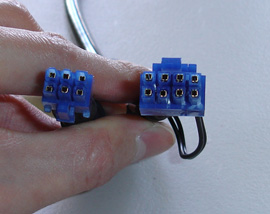
On the left, you can see the difference between the 6-pin PCIe and the 8-pin PCIe connectors. On the right, you can see that the 8-pin PCIe connector can be used as 6-pin PCIe connector by detaching the 2 extra pins.
It’s not easy to see from the picture above but the pinout on the 8-pin PCIe is different from the EPS12V.

The connector of the EPS12V (left) and the 8-pin PCIe (right).
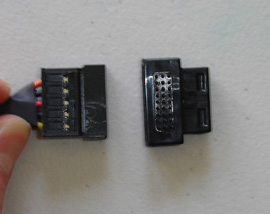
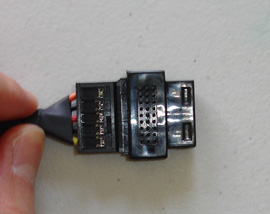
INTERNAL VIEW
Let’s open up the unit and have a look at inside of the power supply. For a 1000 W power supply, the unit looks quite simple in my opinion. From the top, you will see the two rows of black heatsinks covering the components, they are not overly large but they are positioned directly next to the ventilation holes and above the 120mm intake fan so they should help to cool the components fairly well. The primary caps (two large black round things on the upper left of the picture) are hard to identify as there’s no marking on them.
TESTING
|
System Configuration |
|
|
Processor |
Intel E6600 Core 2 Duo (overclocked to 3.2GHz) |
|
Motherboard |
EVGA nForce 680i SLI (BIOS P26) |
|
Memory |
Team Group TXDD2048M800HC4DC-D |
|
Hard Drive |
Seagate Barracuda Barracuda 7200.10 SATA ST3400620AS (16MB cache) Western Digital WD2500KS-00MJB0 SATA (16MB cache) |
|
Graphics Cards |
2 x EVGA 8800 GTX (SLI) |
|
Sound Card |
Creative X-FI |
|
Operating System |
Windows XP SP2 |
Before we take a look at the result, let me comment on my general impression on the Precise 1000W. I installed the NZXT Precise 1000W into my NZXT Zero case without any trouble at all. The standard ATX size of the power supply really makes installation process a breeze as oppose to some other large size PSUs on the market. I have mentioned the placement of the modular connectors’ placement in the past when I review the Enermax Galaxy 850W that they should be placed on the right side of the bundled cable so they can be easily accessed. The Precise 1000W’s placement of the modular connectors on the left side of the bundled cable makes installating modular cables slightly cumbersome once the PSU is inside the system.
As for the noise level of the power supply, it’s absolutely whispering quiet. Unfortunately, the PSU does not come with any temperature or RPM monitoring connector to connect to the motherboard, so I can’t really report the rpm, but it’s really quiet.
Since the Precise 1000W has the ability to split the +12V into 6 different rails or combine them into a single rail with 75A, I tested the PSU with both settings. The idle is tested after Windows has finished loading for about 5 minutes (and the hard drive disk activity light has stopped blinking). The load condition is achieved with the system running 3DMarks06.
Let’s take a look at the performance.
|
Rails |
+3.3V |
+5V |
+12V |
|
Setting: Commbined
|
|
|
|
|
Idle
|
3.42V
|
5.09V
|
12.28V
|
|
Load
|
3.44V
|
5.10V
|
12.29V
|
|
Setting: Split
|
|
|
|
|
Idle
|
3.44V
|
5.10V
|
12.26V
|
|
Load
|
3.44V
|
5.10V
|
12.27
|
All three rails are within the expected ATX specification of 5% tolerance. As you can see, the rails are absolutely stable. During the testing, I didn’t notice much fluctuation among the rails; in fact, the +3.3V and +5V rails hardly changes at all. When the power supply is set in the combined mode, the +12V rails stayed at 12.29V during the majority of the test except during the Canyon Flight test where it jumps to 12.32V for a few seconds in the middle of the test and in the CPU test, the +12V rails actually runs at +12.25V. When the setting is set at split mode, the power supply actually fluctuates between 12.27V and 12.29V once again during the Canyon Flight test and the lowest voltage that was observed during the test is 12.25V.
Once again, I use Everest to monitor the voltage fluctuation. Do keep in mind that the reading in the Everest is not accurate but once again, I merely present this data so we can get an idea on the stability of the rails. What’s nice about the Everest is that it will show the maximum and minimum voltage and in addition, it will calculate the average voltage based on the data points that are taken, so if the average is closer to the maximum or the minimum, then we can conclude that the voltage is fairly stable.
|
Rails |
+3.3V |
+5V |
+12V |
|
Minimum
|
3.26V
|
4.99V
|
11.83V
|
|
Maximum
|
3.26V
|
4.99V
|
11.99V
|
|
Average
|
3.26V
|
4.99V
|
11.96V
|
Once again, the Everest reflects what we have observed with the Multmeter that the +3.3V and the +5V are rails are absolutely stable. We see a small fluctuation in the +12V but it stayed predominantly in the 11.99V.
CONCLUSION
I was extremely surprised by the NZXT’s Precise 1000W power supply since this is the first high end power supply coming from a company whose name is primarily being associated with good quality cases but NZXT has taken their tradition of designing a good reliable cases into their power supply and the end result is a very good product. Not only that this power supply has the aesthetic, the function, the ability to provide stable power, and modular connectors, the fact that it is a standard ATX size means that you don’t ever have to worry about crammed space when you install it in any case. In addition, the ability to switch from multiple +12V rails or combine the +12V rails into a single rail is also an excellent idea as it provides the ability to use either setting as users please.
With the price tag of $334.99 over at Newegg, the Precise 1000W is far from a cheap power supply, but the price is comparable with any other high quality 1000W power supply, so at least it’s not overpriced. What you do get in this power supply is the stable power that is able to power even the most power demanding system on the market today (three 8800GTX graphic cards with the included six PCIe connector and quad core processor) but also the ability to power the next generation of hardware (with the two 8 pins PCI Express graphic cards, such as R600 in Crossfire). Furthermore, NZXT is keeping with industry’s standard warranty on the high end power supply by offering a 3 year warranty. It’s really nice to see NZXT has done well with their first entry into the high end power supply market with the Precise 1000W.
NZXT’s Precise 1000W will receive a score of 9 out of 10 (Extremely Good) for their excellent performance, great features, and looks and will be awarded Bjorn3D’s Seal of Approval.
Pros:
+ Modular connectors
+ Good performance
+ Ample amount of cables included
+ Split +12V rails or combined +12V rail
+ Supports next generation of PCIe graphics cards (two 8-pin PCIe connectors)
+ Cables are fully sleeved
+ 3 year warranty
+ 80% efficiency
+ Quiet
+ Standard ATX PSU size
Cons:
– Expensive
– No temperature monitoring ability
– Better quality/brand caps would have been nice
– Modular connectors to be placed on the right side of the bundled cable to allow easy access
– Include some SATA connectors and at least 1 PCIe connector to the bundled cable would be nice
 Bjorn3D.com Bjorn3d.com – Satisfying Your Daily Tech Cravings Since 1996
Bjorn3D.com Bjorn3d.com – Satisfying Your Daily Tech Cravings Since 1996



